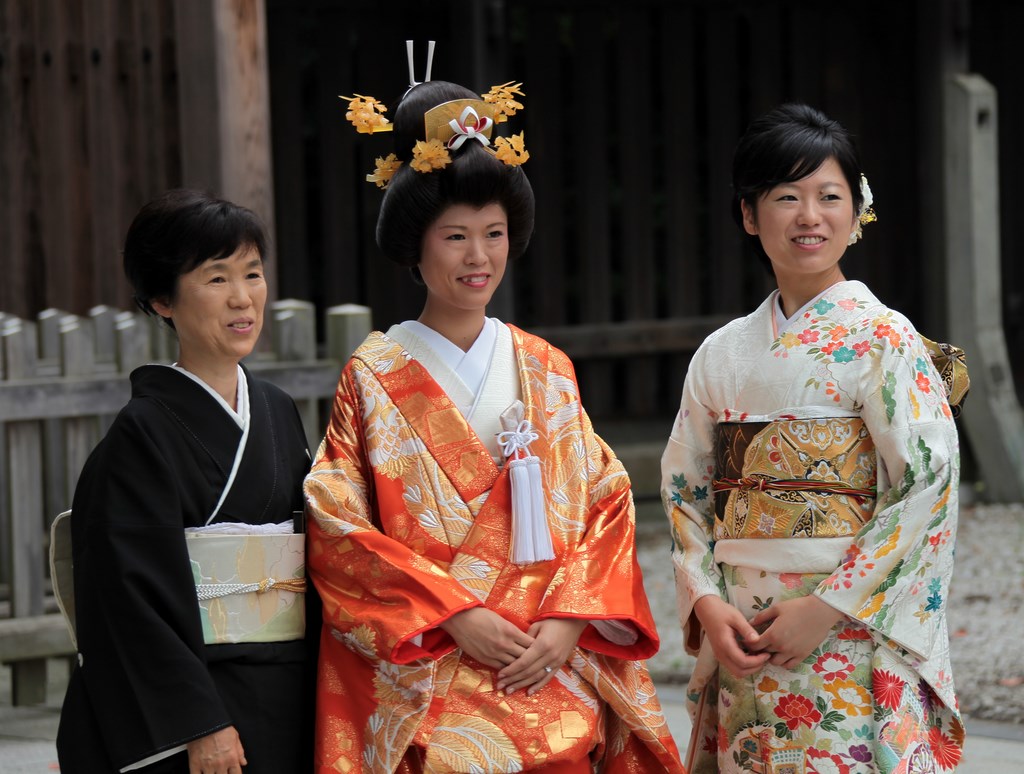KIMONOS PORTES LORS DE MARIAGES
Le kimono (着物, de kiru et mono, littéralement "chose que l'on porte sur soi") est le vêtement traditionnel japonais. Il est souvent confondu, à tort, avec les vêtements d'entraînement des arts martiaux (keikogi, judogi, karategi). Avant l'introduction des vêtements occidentaux au Japon, le terme kimono désignait tous les types de vêtements ; de nos jours il se réfère à la robe traditionnelle japonaise, de forme T, portée essentiellement pour les grandes occasions.
Le kimono descend du kosode, un vêtement utilisé auparavant comme sous-vêtement. Il est formé de rectangles de tissus pliés et cousus, mais jamais recoupés ; il est rectiligne, tombant jusqu'aux pieds ou chevilles, suivant la formalité de l'ensemble et la personne qui le porte. Sa particularité consiste dans ses manches très longues, pouvant aller jusqu'au sol pour les kimonos des jeunes femmes (furisode). Le kimono se porte toujours côté gauche sur côté droit : d'une part cela permettait de cacher une arme (tanto), d'autre part, les morts sont habillés en croisant dans le sens inverse. Il est tenu en place par une large ceinture nouée dans le dos, appelée obi.
Un kimono neuf est particulièrement onéreux, son prix pouvant s’élever à plusieurs milliers d'euros, et le porter est particulièrement compliqué. De nos jours, le kimono est surtout connu par le biais du jour des vingt ans (seijin shiki, 成人式), où les jeunes Japonaises portent un furisode pour la photo traditionnelle. Parmi les plus chers, le furisode porté pour cette fête est souvent loué pour l'occasion. Un usage plus courant du kimono est réservé aux membres de la "très grande bourgeoisie", qui peuvent s'offrir les différents kimonos correspondant aux phases de la vie (jeunesse, âge mur, etc.) et parfois aux saisons. Cependant, ces dernières années ont vu naître un engouement pour les kimonos d'occasion ou sa version simplifiée le yukata.
---------------------------------------------
The kimono (着物) is a Japanese traditional garment. The word "kimono", which literally means a "thing to wear" (ki "wear" and mono "thing"), has come to denote these full-length robes. The standard plural of the word kimono in English is kimonos, but the unmarked Japanese plural kimono is also sometimes used.
---------------------------------------------
The kimono (着物) is a Japanese traditional garment. The word "kimono", which literally means a "thing to wear" (ki "wear" and mono "thing"), has come to denote these full-length robes. The standard plural of the word kimono in English is kimonos, but the unmarked Japanese plural kimono is also sometimes used.
Kimono are T-shaped, straight-lined robes worn so that the hem falls to the ankle, with attached collars and long, wide sleeves. Kimono are wrapped around the body, always with the left side over the right (except when dressing the dead for burial.), and secured by a sash called an obi, which is tied at the back. Kimono are generally worn with traditional footwear (especially zōri or geta) and split-toe socks (tabi).
Today, kimono are most often worn by women, and on special occasions. Traditionally, unmarried women wore a style of kimono called furisode, with almost floor-length sleeves, on special occasions. A few older women and even fewer men still wear the kimono on a daily basis. Men wear the kimono most often at weddings, tea ceremonies, and other very special or very formal occasions. Professional sumo wrestlers are often seen in the kimono because they are required to wear traditional Japanese dress whenever appearing in public.
Today, kimono are most often worn by women, and on special occasions. Traditionally, unmarried women wore a style of kimono called furisode, with almost floor-length sleeves, on special occasions. A few older women and even fewer men still wear the kimono on a daily basis. Men wear the kimono most often at weddings, tea ceremonies, and other very special or very formal occasions. Professional sumo wrestlers are often seen in the kimono because they are required to wear traditional Japanese dress whenever appearing in public.
